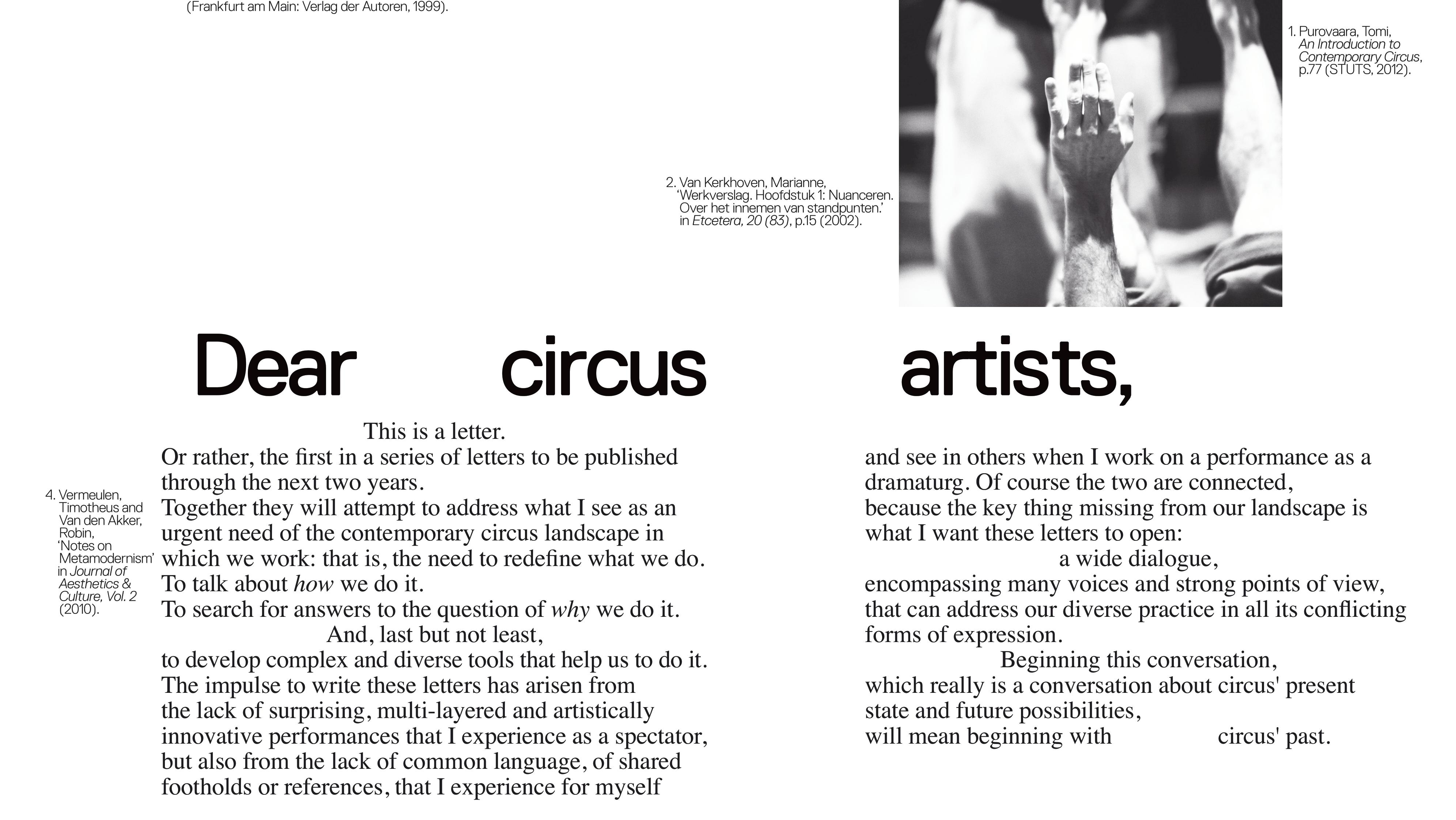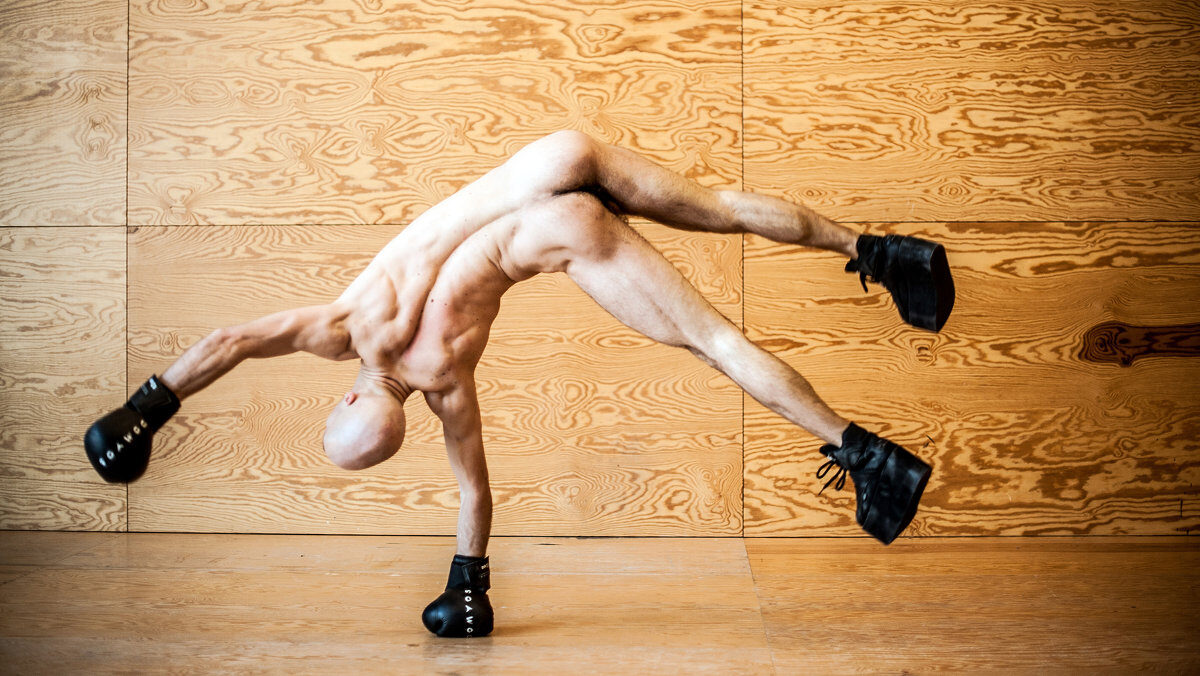The Assemblage
So what is circus? I think we can all point to a sort of limit case of what circus is, and for me this involves four things: a demonstration of practiced physical skill; an intention to be impressive or escapist; a performance that’s primarily visual; and a low level of coding, so you don’t have to have a lot of prior information to understand what’s happening.
But obviously when we get to the contemporary this becomes problematic, because a lot of contemporary shows don’t respond to these criteria. And so you maybe get into this sort of post-circus situation, but the reality is that a lot of circus artists aren’t really thinking about their work in these terms, like either ‘I’m going to conform to these criteria’ or ‘I’m going to push away from these criteria’. It seems to be coming from a different place.
So for me circus was a normative naming function for a set of heterogeneous performative practices. If this sounds super vague it’s because it is, and for me the reason that this is the case is there’s no test for if something is circus or not except its resemblance to things that have been called circus in the past.
To get a sense of what circus might be outside of these criteria I think it’s worthwhile to go back historically and look at where circus emerges from. And circus really emerges from the point at which Philip Astley assembles a bunch of stuff that already exists and names it a circus. He creates this cultural name for something; and that thing is not a dramaturgical choice, it’s more an economic choice. So for me circus is an assemblage.
What is an assemblage? ‘Assemblage’ is a term used by French philosopher Gilles Deleuze during the seventies, and he says an assemblage is ‘a multiplicity which is made up of many heterogeneous terms and which establishes liaisons, relations between them, across ages, sexes and reigns – different natures. Thus, the assemblage’s only unity is that of co-functioning: it is a symbiosis, a “sympathy”.’
An assemblage is anything to the extent that you can call it an individual – so you can have a biological individual, an individual community, an individual culture, an individual institution, an individual nation state. And it’s an assemblage to the extent that you can say it’s made up of different parts, but that something emerges from the parts being together that surpasses anything that the parts can do by themselves.
So assemblages have two important properties: one is this emergence thing, that the whole has properties that the parts don’t contain themselves. In the case of Astley we can point to all of the cultural associations and aesthetic associations of traditional circus, which come from grouping all of these disciplines together – in a way that none of the disciplines had been before they were grouped – so that something emerges in culture that didn’t exist before. These things were assembled. But what I think is the more important and maybe the more interesting property of assemblages is that the components of an assemblage all have relations of exteriority – so all of the component parts are not isolated within the assemblage, but they also interact with things that are outside the assemblage. So you can look for example at trick horseback riding and its relationship with the military – it’s not only defined by what it does in circus.
Assemblages go through processes of territorialisation or deterritorialisation. Territorialisation refers to the extent to which the different components of that assemblage are homogeneous, and how much being part of the assemblage defines what those component parts are. And I would argue that circus went through a period of extreme territorialisation up through the golden age of circus in the beginning of the 20th Century, when it really solidifies an identity and form for itself, but that starting in the late 20th Century it goes through a rapid process of deterritorialisation where interaction with external elements takes those parts and makes those parts within circus as a whole less homogeneous and less like each other.
So what are some of the deterritorialisation factors of circus today? There are economic factors that change the viability of the traditional touring model. There’s increased mobility that allows artists to function more as individual parts, so you get less these very strong aesthetic communities and more something that’s networked very strongly with the outside world because individuals are leaving their communities and coming back to the field. And of course there’s the institutionalisation of circus education.
I think the most important factor though is an increased place of cultural capital for the artist at a time when our economic model has changed: we’ve stopped making things with our hands and we’re doing more communication and more creative work. To be a good worker today you have to be spontaneous, you have to be innovative – all these things which are traditionally associated with art. Because of these changing economic circumstances and the changing economy the artist becomes something that everyone wants to be, and our education system is made in such a way that it encourages you to want to think that you’re very spontaneous and innovative and have a lot to express. And that obviously is reflected in the way circus institutions are run.
My proposition is that circus has been deterritorialised to the extent that it’s undergone a phase shift, and we can no longer talk about it as something that’s strongly organised around a central concept – but that is instead many different sets of sets, all of which are related but weakly related. I think that’s why we have a hard time defining what circus is.
I’d like to return to Bauke’s comment in her open letter about staging contemporary subjectivities. I think that that’s where the potential lies in circus as an assemblage, because I think the contemporary subject is also experiencing this rapid process of deterritorialisation where subjectivities are less organised around a central concept and instead have to perform differently in different situations. People tend to take on more identities and this is why concepts like identity politics or very strong politics organised around race or gender or sexuality seem to have less currency right now – because the individual is experienced more as a deterritorialised being that can mean different things in different situations.
So I think we really need to make room for these heterogeneous definitions and highlight ways circus is already networked with the outside world. It’s essential that the individual question the way her work functions in society and the way that her work is shaped by the structure of power in society, how practices are socially shaped, and what codes already exist within her practice that shape it in ways she is perhaps not aware of. And I think in mapping these relations of power the circus artist can claim a greater autonomy and claim to have a more objective claim to authorship.










